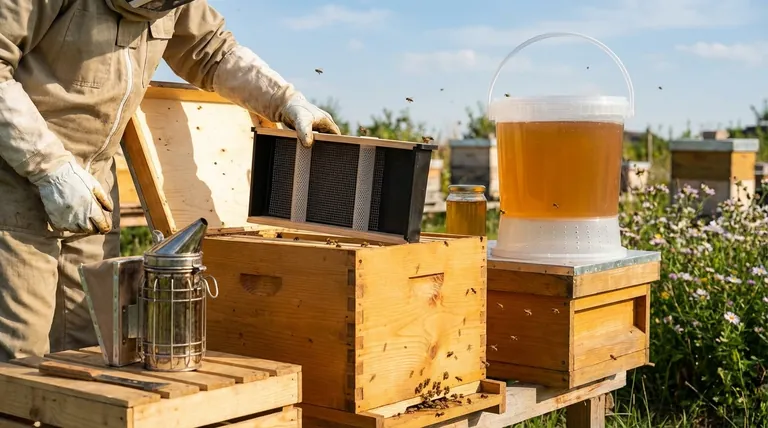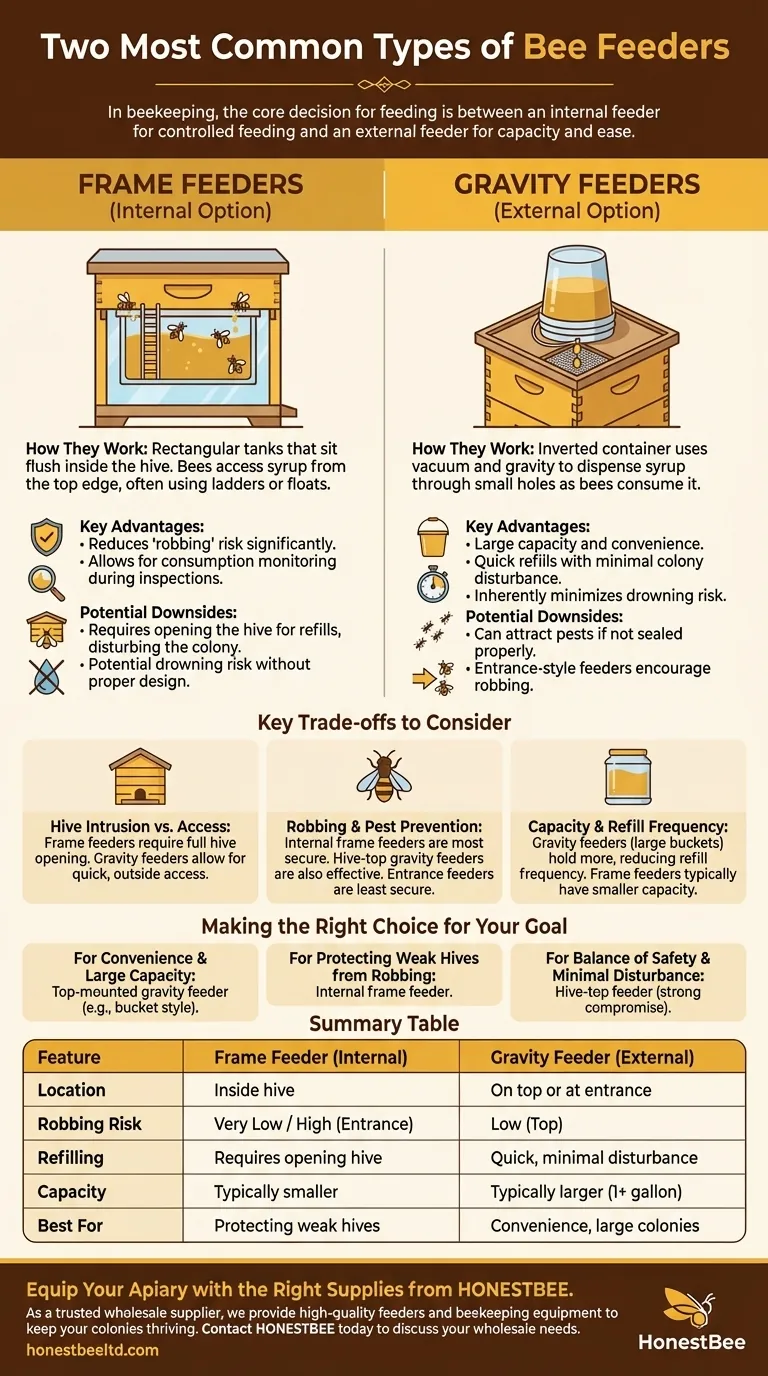In beekeeping, the two most common and fundamentally different types of feeders are the frame feeder, which sits inside the hive, and the gravity feeder, which typically sits on top. While many variations exist, almost all designs fall into one of these two functional categories.
The core decision a beekeeper must make is between an internal feeder that integrates with the hive structure for controlled feeding and an external feeder that prioritizes capacity and ease of refilling without disturbing the colony.

Understanding Frame Feeders (The Internal Option)
A frame feeder, sometimes called a division board feeder, is a container designed to hang inside the hive body, taking the place of one or more frames.
How They Work
These feeders are essentially thin, rectangular tanks that sit flush with the other frames. Bees access the syrup from the top edge, often with the help of ladders or floats designed into the feeder to prevent them from drowning.
Key Advantages
The primary benefit of a frame feeder is its location. Since it's inside the hive, it significantly reduces the risk of "robbing," where bees from other colonies are attracted to the food source and attack the hive. It also allows the beekeeper to easily monitor consumption during regular hive inspections.
Potential Downsides
The main drawback is that you must open the hive to refill the feeder, which disturbs the colony. Additionally, older or poorly designed models can pose a drowning risk to the bees if they lack proper internal ladders or textured surfaces for grip.
Understanding Gravity Feeders (The External Option)
Gravity feeders use a simple principle: an inverted container filled with syrup uses vacuum and gravity to dispense the liquid through small holes as the bees consume it. Common examples include bucket feeders, can feeders, and Boardman (entrance) feeders.
How They Work
Typically placed on top of the hive over an inner cover hole, these feeders allow bees to access the syrup from below through a screen or perforated lid. The vacuum seal prevents the syrup from dripping out all at once.
Key Advantages
Gravity feeders are valued for their large capacity and convenience. A beekeeper can quickly refill them—or swap an empty bucket for a full one—with minimal disturbance to the colony. This design also inherently minimizes the risk of bees drowning.
Potential Downsides
If not sealed properly on the hive top, these feeders can attract ants and other pests. Entrance-style gravity feeders (Boardman feeders) are notorious for encouraging robbing because the food source is located at the hive's front door, advertising its presence to nearby colonies.
Key Trade-offs to Consider
Choosing a feeder involves balancing convenience, capacity, and the health of the colony. Each design philosophy presents a different set of compromises.
Hive Intrusion vs. Ease of Access
Frame feeders require you to fully open the hive for every refill, which can be disruptive and break the hive's propolis seals. Gravity feeders, especially hive-top models, allow for "at a glance" checks and quick refilling from the outside.
Robbing and Pest Prevention
Internal frame feeders are the most secure against robbing. Hive-top feeders are also quite effective at preventing robbing and pests. Entrance feeders are the most likely to cause problems with both.
Capacity and Refill Frequency
Gravity feeders, particularly large bucket styles, can hold a gallon or more of syrup. This drastically reduces the frequency of refills compared to most frame feeders, which typically have a smaller capacity.
Making the Right Choice for Your Goal
Your beekeeping philosophy and specific hive needs should dictate your choice.
- If your primary focus is convenience and large capacity: A top-mounted gravity feeder, such as a bucket feeder, is the most efficient choice for feeding a large amount of syrup with minimal effort.
- If your primary focus is protecting a weak hive from robbing: An internal frame feeder is the safest option, as it keeps the food source entirely contained within the hive.
- If you want a balance of safety and minimal disturbance: A hive-top feeder offers a strong compromise, keeping the syrup protected from robbers while allowing for easy refills.
Ultimately, understanding how each feeder type impacts bee behavior is the key to supporting a healthy and productive colony.
Summary Table:
| Feature | Frame Feeder (Internal) | Gravity Feeder (External) |
|---|---|---|
| Location | Inside the hive body | On top of or at the hive entrance |
| Robbing Risk | Very Low | High (Entrance style); Low (Top style) |
| Refilling | Requires opening the hive | Quick, minimal disturbance |
| Capacity | Typically smaller | Typically larger (e.g., 1+ gallon) |
| Best For | Protecting weak hives, controlled feeding | Convenience, feeding large colonies |
Equip Your Apiary with the Right Supplies from HONESTBEE
Choosing the correct feeder is just one part of successful hive management. As a trusted wholesale supplier for commercial apiaries and beekeeping equipment distributors, HONESTBEE provides the durable, high-quality supplies you need to keep your colonies thriving.
We offer a wide range of beekeeping equipment, including various feeder types, to meet the specific demands of your operation. Let our expertise support your success.
Contact HONESTBEE today to discuss your wholesale needs and ensure your beekeeping business is fully equipped.
Visual Guide

Related Products
- Professional In-Hive Frame Bee Feeder by HONESTBEE
- Professional Hive Front Entrance Bee Feeder
- Classic Boardman Entrance Bee Feeder Hive Front Feeding Solution
- Boardman Entrance Bee Feeder Durable Galvanized Steel and Wood Construction for Beekeeping
- 3.5L Plastic Beehive Frame Feeder Deep Frame Water Feeder for In Hive Use
People Also Ask
- What is a frame feeder? A High-Capacity, Secure In-Hive Feeding Solution
- What are the two most popular types of honey bee feeders? A Guide to Frame and Bucket Feeders
- What are frame feeders, and what are their advantages? Essential for Cold Weather & Efficient Feeding
- What are the types of internal feeders used in beekeeping? Optimize Your Hive's Nutrition Strategy
- What are the advantages of using a frame feeder? Boost Hive Health with In-Hive Feeding



















